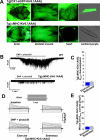Exercise-induced expression of cardiac ATP-sensitive potassium channels promotes action potential shortening and energy conservation
- PMID: 21439969
- PMCID: PMC3103621
- DOI: 10.1016/j.yjmcc.2011.03.010
Exercise-induced expression of cardiac ATP-sensitive potassium channels promotes action potential shortening and energy conservation
Abstract
Physical activity is one of the most important determinants of cardiac function. The ability of the heart to increase delivery of oxygen and metabolic fuels relies on an array of adaptive responses necessary to match bodily demand while avoiding exhaustion of cardiac resources. The ATP-sensitive potassium (K(ATP)) channel has the unique ability to adjust cardiac membrane excitability in accordance with ATP and ADP levels, and up-regulation of its expression that occurs in response to exercise could represent a critical element of this adaption. However, the mechanism by which K(ATP) channel expression changes result in a beneficial effect on cardiac excitability and function remains to be established. Here, we demonstrate that an exercise-induced rise in K(ATP) channel expression enhanced the rate and magnitude of action potential shortening in response to heart rate acceleration. This adaptation in membrane excitability promoted significant reduction in cardiac energy consumption under escalating workloads. Genetic disruption of normal K(ATP) channel pore function abolished the exercise-related changes in action potential duration adjustment and caused increased cardiac energy consumption. Thus, an expression-driven enhancement in the K(ATP) channel-dependent membrane response to alterations in cardiac workload represents a previously unrecognized mechanism for adaptation to physical activity and a potential target for cardioprotection.
Copyright © 2011 Elsevier Ltd. All rights reserved.
Figures





Similar articles
-
Reduction in number of sarcolemmal KATP channels slows cardiac action potential duration shortening under hypoxia.Biochem Biophys Res Commun. 2011 Dec 2;415(4):637-41. doi: 10.1016/j.bbrc.2011.10.125. Epub 2011 Nov 3. Biochem Biophys Res Commun. 2011. PMID: 22079630 Free PMC article.
-
ATP-sensitive potassium channels: metabolic sensing and cardioprotection.J Appl Physiol (1985). 2007 Nov;103(5):1888-93. doi: 10.1152/japplphysiol.00747.2007. Epub 2007 Jul 19. J Appl Physiol (1985). 2007. PMID: 17641217 Review.
-
KATP channel inhibition blunts electromechanical decline during hypoxia in left ventricular working rabbit hearts.J Physiol. 2017 Jun 15;595(12):3799-3813. doi: 10.1113/JP273873. Epub 2017 Mar 13. J Physiol. 2017. PMID: 28177123 Free PMC article.
-
Disruption of sarcolemmal ATP-sensitive potassium channel activity impairs the cardiac response to systolic overload.Circ Res. 2008 Oct 24;103(9):1009-17. doi: 10.1161/CIRCRESAHA.107.170795. Epub 2008 Sep 18. Circ Res. 2008. PMID: 18802029 Free PMC article.
-
Cardiac KATP channels in health and disease.J Mol Cell Cardiol. 2005 Jun;38(6):937-43. doi: 10.1016/j.yjmcc.2005.02.026. Epub 2005 Apr 25. J Mol Cell Cardiol. 2005. PMID: 15910878 Free PMC article. Review.
Cited by
-
KATP Channels in the Cardiovascular System.Physiol Rev. 2016 Jan;96(1):177-252. doi: 10.1152/physrev.00003.2015. Physiol Rev. 2016. PMID: 26660852 Free PMC article. Review.
-
Short-term exercise-induced protection of cardiovascular function and health: why and how fast does the heart benefit from exercise?J Physiol. 2022 Mar;600(6):1339-1355. doi: 10.1113/JP282000. Epub 2022 Mar 3. J Physiol. 2022. PMID: 35239189 Free PMC article. Review.
-
Exercise and Cardioprotection: A Natural Defense Against Lethal Myocardial Ischemia-Reperfusion Injury and Potential Guide to Cardiovascular Prophylaxis.J Cardiovasc Pharmacol Ther. 2019 Jan;24(1):18-30. doi: 10.1177/1074248418788575. Epub 2018 Jul 24. J Cardiovasc Pharmacol Ther. 2019. PMID: 30041547 Free PMC article. Review.
-
Contributions of A2A and A2B adenosine receptors in coronary flow responses in relation to the KATP channel using A2B and A2A/2B double-knockout mice.Am J Physiol Heart Circ Physiol. 2011 Dec;301(6):H2322-33. doi: 10.1152/ajpheart.00052.2011. Epub 2011 Sep 23. Am J Physiol Heart Circ Physiol. 2011. PMID: 21949117 Free PMC article.
-
Endurance exercise training normalizes repolarization and calcium-handling abnormalities, preventing ventricular fibrillation in a model of sudden cardiac death.J Appl Physiol (1985). 2012 Dec 1;113(11):1772-83. doi: 10.1152/japplphysiol.00175.2012. Epub 2012 Oct 4. J Appl Physiol (1985). 2012. PMID: 23042911 Free PMC article.
References
-
- Guyton AC, Hall JE. Sport physiology. In: Guyton AC, Hall JE, editors. Textbook of medical physiology. Elsevier Saunders; Philadelphia, PA: 2006. pp. 1062–1062-1065.
-
- Aguilar-Bryan L, Bryan J. Molecular biology of adenosine triphosphate-sensitive potassium channels. Endocr Rev. 1999;20:101–35. - PubMed
-
- Noma A. ATP-regulated K+ channels in cardiac muscle. Nature. 1983;305:147–8. - PubMed
-
- Seino S, Miki T. Physiological and pathophysiological roles of ATP-sensitive K+ channels. Prog Biophys Mol Biol. 2003;81:133–76. - PubMed
Publication types
MeSH terms
Substances
Grants and funding
LinkOut - more resources
Full Text Sources
Molecular Biology Databases

